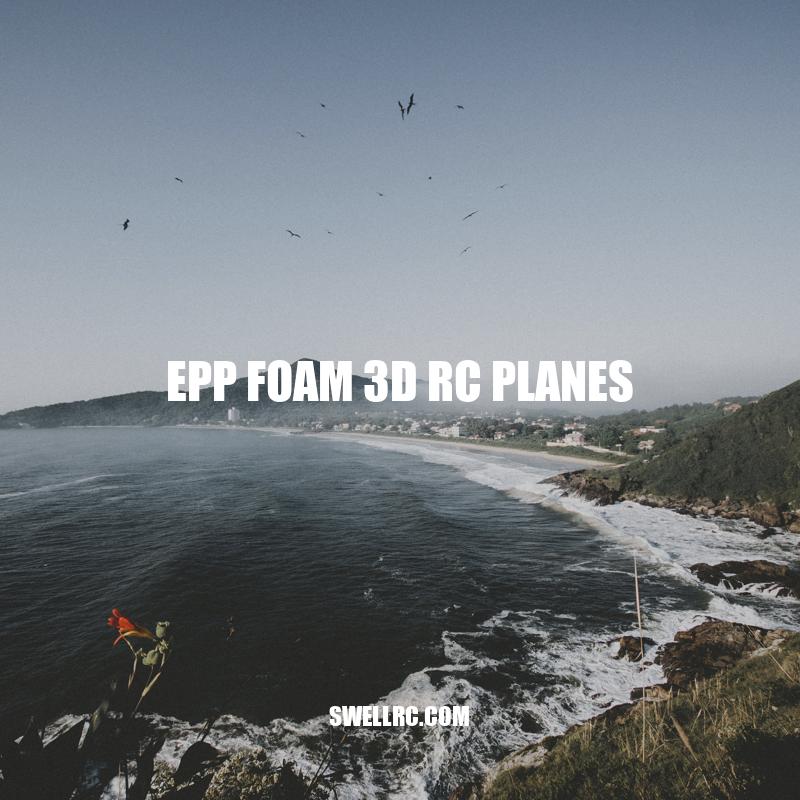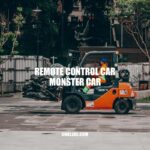Title: EPP Foam 3D RC Planes: A Guide to Building and Flying.
EPP foam 3D RC planes are a type of model aircraft that offer a unique and thrilling experience for pilots of all levels. Made from Expanded Polypropylene (EPP) foam, these planes are both lightweight and durable, making them an excellent choice for aerobatic maneuvers. Unlike traditional RC planes, which prioritize stability and speed, EPP foam 3D RC planes focus on maneuverability and acrobatics. This allows pilots to perform extreme flips, loops, and rolls, as well as other intricate maneuvers that are impossible with other types of planes. The versatility of EPP foam 3D RC planes has made them popular among hobbyists and enthusiasts alike, as they offer a challenging yet rewarding experience in radio-controlled flight.
EPP foam is becoming increasingly popular among RC plane enthusiasts due to its unique properties. Compared to other materials used in model aircraft, such as balsa wood and foam board, EPP foam is extremely durable, flexible, and resilient. This allows EPP foam 3D RC planes to withstand the intense forces and collisions that are common during aerobatic maneuvers. Additionally, EPP foam is lightweight, making it easier for pilots to fly and maneuver their planes. EPP foam also allows for more intricate construction designs, which can enhance the performance of the RC plane. This makes EPP foam 3D RC planes a popular choice among hobbyists who prioritize the building process as much as the flying. Combined with powerful motors and advanced electronics, EPP foam 3D RC planes offer a thrilling and challenging experience for pilots looking to push the limits of radio-controlled flight.
Advantages of EPP Foam 3D RC Planes
EPP foam 3D RC planes offer a unique set of advantages over other types of RC planes. Some of the key benefits of EPP foam 3D RC planes include:
- Durability: EPP foam is flexible and resilient, allowing it to withstand the intense impacts and collisions that are common during aerobatic maneuvers.
- Lightweight: EPP foam is a lightweight material, which helps RC planes achieve a better power-to-weight ratio. This translates to better performance and maneuverability during flight.
- Stiffness: EPP foam is also stiff, allowing planes to maintain their shape and resistance during flight.
- Safety: EPP foam is a safe material that absorbs impacts and mitigates damage, making it a good choice for beginners and hobbyists.
- Maneuverability: EPP foam 3D RC planes offer a high level of maneuverability, which allows pilots to perform more complex and acrobatic maneuvers.
In addition to these advantages, EPP foam 3D RC planes are also relatively affordable and easy to construct. There are many websites and online retailers that offer EPP foam 3D RC plane kits and parts, making it easy for hobbyists to build and customize their own planes. Popular websites include HobbyKing, Flite Test, and Motion RC. These websites offer a wide range of EPP foam 3D RC planes, including popular models like the Sbach 342 and the Extra 330SC. Additionally, there are many accessories and upgrades available, including propellers, batteries, and electronic speed controllers (ESCs).
What are the advantages of EPP?
Expanded Polypropylene (EPP) has several advantages due to its unique properties, such as exceptional energy absorption, buoyancy, water and chemical resistance, thermal insulation, and high strength to weight ratio. Additionally, it offers multiple impact resistance and 100% recyclability. EPP finds applications in automotive, aerospace, packaging, and sports equipment industries, among others.
Essential Features of EPP Foam 3D RC Planes
To achieve the intricate and acrobatic maneuvers associated with EPP foam 3D RC planes, they need to have specific design features. Some of the essential features of EPP foam 3D RC planes include:
- High power-to-weight ratio: EPP foam 3D RC planes need a high power-to-weight ratio to support their advanced aerobatic capabilities. This means that the motor needs to be powerful enough to support the plane’s weight and perform complex maneuvers.
- Large control surfaces: EPP foam 3D RC planes require large control surfaces to allow for more precise and complex movements. This includes larger elevators and rudders, as well as ailerons that extend all the way to the wingtips.
- Low wing loading: EPP foam 3D RC planes need to have a low wing loading to support their advanced aerobatic capabilities. This means that the total weight of the plane needs to be spread out over a large wing surface area to prevent stalling during flight.
- Rigid and precise tail: The tail of an EPP foam 3D RC plane needs to be stiff and precise to allow for complex maneuvers like hovering and torque rolling.
- Symmetrical airfoil: EPP foam 3D RC planes use a symmetrical airfoil which means both sides of the wing are the same shape. This allows for more versatile aerobatics and gives greater control over the plane.
Interestingly, EPP foam is also used in other industries such as automotive, medical, and packaging due to its durability and lightweight properties. In the RC industry, EPP foam 3D RC planes are one of the most popular types of planes for aerobatic flying due to their unique design features. Some popular EPP foam 3D RC plane models include the Slick 360, Edge 540, and Yak 55.
Twisted Hobbys makes the Slick 360, which has a 35 inch wingspan and runs at around $99. All major features of EPP planes, including a low wing loading, symmetrical airfoil, and large control surfaces, are present in the Slick 360. Pilot RC offers the Edge 540, which has a more impressive 60 inch wingspan and is priced around $399. The Yak 55 is made by Foam-Tac and has a 44 inch wingspan at around $149.
What are the characteristics of EPP foam?
Expanded Polypropylene (EPP) is a versatile closed-cell bead foam that offers excellent energy absorption, thermal insulation, buoyancy, and water and chemical resistance. It has outstanding multiple impact resistance, high strength-to-weight ratio, and is 100% recyclable. For more information on EPP foam products, you can check out the website of manufacturers like JSP or Clark Foam Products.
Building Your EPP Foam 3D RC Plane
Building an EPP foam 3D RC plane can be an exciting and rewarding experience for hobbyists. Here are some tips to help you get started:
- Choose a model: There are many EPP foam 3D RC planes available on the market, so choose one that fits your skill level and flying preferences. Some popular models include the Slick 360, Edge 540, and Yak 55.
- Gather the necessary tools and materials: To build your EPP foam 3D RC plane, you will need a variety of materials including EPP foam sheets, hot glue, carbon fiber rods, and a suitable motor and power system. You will also need tools such as a hot wire cutter, a heat gun, and hobby knives.
- Assemble the fuselage: Begin building your EPP foam 3D RC plane by assembling the fuselage. This involves carefully cutting and gluing EPP foam sheets according to the model plans and using carbon fiber rods for reinforcement.
- Attach the wings and tail: Once the fuselage is complete, attach the wings and tail section using hot glue and carbon fiber rods. Be sure to check the alignment and balance of the plane before attaching these sections.
- Install the motor and power system: Choose an appropriate motor and power system for your EPP foam 3D RC plane and install it according to the manufacturer’s instructions.
- Test the plane: Before flying your EPP foam 3D RC plane, be sure to make some test flights to ensure that everything is balanced and working correctly.
There are many online resources available for building EPP foam 3D RC planes, including tutorials and instructional videos. Some popular websites for purchasing EPP foam 3D RC plane kits and materials include Twisted Hobbys, Foam-Tac, and Motion RC.
How do you mold EPP foam?
To mold EPP foam, you will need a mold, a heat gun, and a temperature controller. First, preheat the heat gun to the desired temperature, then place the foam in the mold and heat it evenly with the heat gun until it begins to soften and take the shape of the mold. Hold the foam in place until it cools and hardens. For more detailed instructions and visual aid, you may refer to this informative YouTube video: https://www.youtube.com/watch?v=D7h8S9wBFSE.
Tips for Flying Your EPP Foam 3D RC Plane
Flying an EPP foam 3D RC plane is an exhilarating experience, but it can also be challenging, especially for those new to the hobby. Here are some tips to help you get the most out of your flights:
- Start with basic maneuvers: Before attempting more advanced aerobatics, start with basic maneuvers such as takeoff, landing, and straight and level flight. Practice these until you feel confident before moving on to more complex maneuvers.
- Choose the right weather conditions: Flying an EPP foam 3D RC plane in high winds or heavy rain can be dangerous and may cause damage to your plane. Choose calm, clear days with moderate temperatures for optimal flying conditions.
- Know your plane’s limitations: While EPP foam 3D RC planes are sturdy and durable, they still have their limitations. Be aware of your plane’s capabilities and don’t push it beyond its limits.
- Keep an eye on your battery life: Make sure to keep track of your battery life during flights. Running out of battery mid-flight can result in a crash and damage to your plane.
- Join a club or community: Joining an RC plane club or community can be a great way to connect with other hobbyists and learn from more experienced pilots. You can also get advice on flying techniques and troubleshooting any issues with your plane.
By following these tips, you can enjoy the thrill of flying your EPP foam 3D RC plane safely and confidently. Remember to always practice caution and respect other pilots and their planes when flying in shared spaces. With some patience and practice, you can become a skilled pilot and enjoy the many benefits of this exciting hobby!



